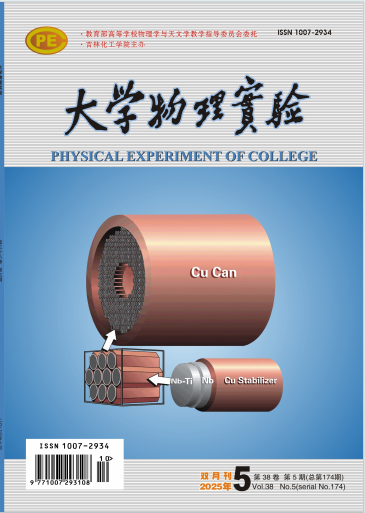|
|
Theoretical and Experimental Research on Fiber Optic Displacement Sensor
Collect
LIU Longjiang, HU Deyi , WEN Hean, LI Jiahui, HONG Yayue, NIU Wenzhe
Physical Experiment of College. 2025, 38 (5): 1-6.
doi:10,14139/j.cnki.cn22-1228.2025.05.001
For the two cases of uniform and Gaussian distributions of light intensity in the emitted light field,a quantitative relationship between the sensor output and displacement was derived.Subsequently,a theoretical model of the fiber optic displacement sensor was established,and this model was subjected to simulation and analysis.Reflective surfaces were fabricated using materials such as iron,copper,aluminum,and mirror stickers.
Through experimental verification,the effectiveness of the theoretical model was validated. This research provides a theoretical foundation for the development of fiber optic sensors and for experimental teaching in
relevant academic fields.
Related Articles |
Metrics
|
|
|
Design of an Experimental Module on Fabrication and Dielectric/Optical Characterization of Stacked Gate Dielectrics
Collect
WANG Leini , ZHOU Ruiyang , HU Pengyu , JIANG Xianwei , YANG Bo
Physical Experiment of College. 2025, 38 (5): 7-12.
doi:10,14139/j.cnki.cn22-1228.2025.05.002
As microelectronics technology advances toward the nanoscale,the development of high-performance dielectric materials has become central to enhancing integrated circuit performance.Addressing the demand for
gate dielectric materials with high dielectric constant (high-k)and low leakage current in transparent electronic devices,this paper designs an experimental module tailored for Microelectronics and Integrated Circuit Engineering programs.Focusing on the CeAlO2 /Al2O3 stacked gate dielectric as the core subject,the structure is constructed by preparing CeAlO2 thin films via a solution process and depositing a 4 nm ultra-thinAl2O3 passivation layer using Atomic Layer Deposition (ALD)technology.The experiment comprehensively covers thin film fabrication,dielectric property testing (capacitance per unit area C ox ,and leakage current density J leak ),and optical characterization (transmittance,absorption spectra). This integrated approach cultivates students' systematic innovation capabilities spanning from material design to device application.The design effectively bridges semiconductor processing technology with device physics knowledge,enhancing students' engineering literacy in solving cutting-edge electronic device challenges.
Related Articles |
Metrics
|
|
|
Improving the Measurement Accuracy of the Sound Velocity Measuring Instrument Using the Capacitive Sensor Ranging System
Collect
CHEN Aopeng, DONG Jinyu, ZHU Wenbin, MA Tiancheng, LONG Yangzhou, HE Lianhui, YI Yuanchao, WANG Botao, ZHANG Xiaofeng, XIN Hong
Physical Experiment of College. 2025, 38 (5): 34-37.
doi:10.14139/j.cnki.cn22-1228.2025.05.007
This experiment improves the ultrasonic velocity measurement instrument using a capacitive sensor ranging system.By controlling the capacitive sensor measures the data at the threshold voltage position through the output voltage of the piezoelectric transducer receiving sound waves,it achieves precise and automatic wavelength measurement,reducing human error and improving measurement efficiency. It is particularly advantageous when measuring the speed of sound in media with real-time changes in state.In the experiment,the first step was to investigate the impact of the threshold voltage on the experimental results.The results show that increasing the threshold voltage can improve measurement accuracy.When the threshold voltage is 11 V,the propagation speed of sound in air is,the relative uncertainty is,and the percentage deviation is.Compared to before the improvement,the relative uncertainty has decreased by,and the percentage deviation has decreased by.This experiment will provide strong support for research and application in related fields.
Related Articles |
Metrics
|
|







